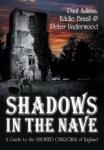
The authors of the very well received The Borley Rectory Companion have compiled a guide to seventy-five ecclesiastical buildings in England which have paranormal stories attached to them. They range from cathedrals to the smallest of chapels, plus some no longer in use as places of worship. Entries are handily arranged by geographic region and then listed by county, making it easy to find the buildings in a particular area. In addition to the full entries, there is an appendix with another forty which have abbreviated details, using the same geographic classification. To make the guide even more helpful, each entry in the main section has a brief note on its whereabouts, and all entries have Ordnance Survey grid references. Country maps, in both the main section and the appendix, also indicate locations.
As might be expected, given the authors’ credentials, the research has been carefully done and they sketch in the historical background before describing the ghostly stories. The book is lavishly illustrated with black and white photographs, mostly by Eddie Brazil. These are very atmospheric, though perhaps he has been over-lavish in his use of the red filter (or its digital equivalent), leading to glowering skies which suggest he prefers to work in bad weather.
Some of the cases are well known, others less so, and it is good to see them have an airing. Personally, I was pleased to see St Giles, Camberwell, where my parents were married and I was baptised. Unsurprisingly, Borley’s church is included, but there is no warning that the village’s inhabitants do not take kindly to visitors and it is difficult to gain entry to the church. This prompts the thought that, more so than with the normal gazetteer, a guide to haunted churches, priories, abbeys and so on, which is designed to stimulate paranormal tourism, raises ethical considerations that the authors do not address. Some clerics may be uncomfortable with the idea of people arriving hoping to witness a ghost, and judging by accounts from Borley over the years, not all ghost-seeking visitors treat churches and their environs with respect.
The authors do express the hope that those who use Shadows in the Nave as a source for their outings will behave responsibly, but they note the relationship between ghost-hunting and the media, presumably concerned that exaggerated depictions of the pursuit on television will encourage a heightened emotional response that not only inhibits careful investigation, but will also bring the enterprise into disrepute. On the other hand, if you are in an area, and all other things are equal, it adds extra interest to know that a particular church has an unusual history, and like pubs which appear in ghost books, featured churches may find their revenues increasing as a result.
The introduction discusses the macabre associations of churches, and wonders how it is that churches possess the attributes of spookiness necessary to a good ghost story. They should be places of comfort but can be unnerving; I remember that when I was head choirboy at St Barnabas, Dulwich (which was sadly destroyed by fire in 1992), I was occasionally sent by the choirmaster from the tower room where we practised to fetch music kept in the vestry. I disliked walking through the creepy, semi-dark church on my own, and was always relieved to get back to the sanctuary of the practice room; shadows in the nave indeed. As the authors aptly put it, a church is “an icon to feed the imagination with dark fancies”. There is plenty here to get your teeth into.

